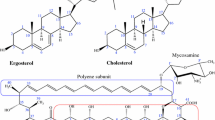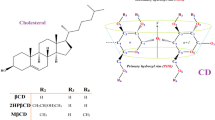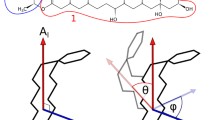Abstract.
A molecular model of ionic channel formed by flexible molecules of amphotericin B and cholesterol is proposed. Complexes with axial symmetry from 5 to 11 were simulated. In contrast to the model of the channel formed from rigid molecules, flexible molecules form a tightly packed structure consolidated by both dispersive forces and intermolecular hydrogen bonds. Contributions of a lactone ring, polar heads, cholesterol and lipid environments to the global energy of the complex formation are discussed. Among the complexes capable of ionic transport, that of axial symmetry eight is preferable. Two types of complexes, differing by the number of intramolecular hydrogen bonds, are shown to be possible.
Similar content being viewed by others
Author information
Authors and Affiliations
Additional information
Received: 25 April 1997/Revised: 20 November 1997
Rights and permissions
About this article
Cite this article
Silberstein, A. Conformational Analysis of Amphotericin B — Cholesterol Channel Complex. J. Membrane Biol. 162, 117–126 (1998). https://doi.org/10.1007/s002329900349
Issue Date:
DOI: https://doi.org/10.1007/s002329900349




